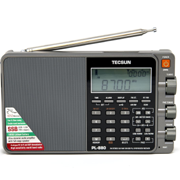
Radio Equipment |
Short Wave ListeningWhilst in the developed world, listening to short wave radio is seen as somewhat of a niche hobby, in many parts of the developing world it is the way in which people receive their daily news and for many, their only access to non government controlled information, education and international news. The equipment required to tune in to short wave broadcasts is very straightforward and inexpensive and is well within even the most meagre budget, though using more expensive equipment will enable you to hear a lot more, or to tune into broadcasts a lot more easily. Radios and Receivers
AntennasThe only additional item which can help improve reception is an antenna (a.k.a. an aerial). Almost any length of any kind of wire, attached to the antenna on the receiver itself, will improve reception. The higher up you you can get your wire (slung over a tree for example), the better it will perform. Also, generally speaking, the longer the wire, the better it works (officionados of such antennas call them a 'long wire' for good reason!) Whilst antennas which are outdoors are more effective, even a few metres of wire strung across a window or inside a room will make a difference, though indoor antennas can often collect a lot of counter-productive noise and interference from electrical devices such as computers and televisions (which are particularly bad at generating all manner of annoying signals across the short-wave bands), so running the wire outdoors, or by a window, is always better, if that is possible. Some radios may have a separate socket into which you can directly connect your long wire but just attaching one end to the telescopic antenna on the radio will usually make a very positive difference. Reference Books
Remember that a list of frequencies is only as good as the date it was produced. This web-site is updated roughly every month, whereas a printed book may become out of date very quickly. Broadcasters tend to have a summer and a winter frequency schedule (not least to take account of daylight saving time) and often change frequencies more regularly than this to sort out interference problems, or as radio propagation changes. The World Radio and TV Handbook (WRTH) is probably the best known tome for short wave listeners (SWL's) and is updated each year. The authors of the WRTH are almost all experienced SWL's from around the world and are often professionals whose jobs involve short wave broadcasting of some kind and so it is complied by those who know what they are talking about. That being said, only the most recently published version will be of any use, given the continually changing frequencies used by many short-wave broadcasters. |


